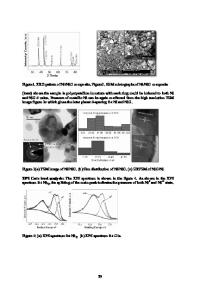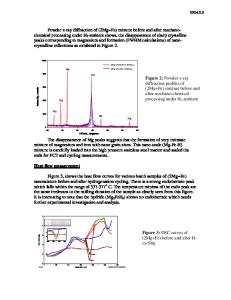One-step hydrothermal synthesis of transition metal oxide electrode material for energy storage applications
- PDF / 2,495,861 Bytes
- 13 Pages / 595.276 x 790.866 pts Page_size
- 46 Downloads / 345 Views
One-step hydrothermal synthesis of transition metal oxide electrode material for energy storage applications Vadivel Siva1,2, Anbazhagan Murugan1,2, Abdul samad Shameem1,2, and Sultan Asath Bahadur1,2,*
1
Department of Physics, School of Advanced Sciences, Kalasalingam Academy of Research and Education, Krishnankoil 626 126, India 2 Condensed Matter Physics Laboratory, International Research Centre, Kalasalingam Academy of Research and Education, Krishnankoil 626 126, India
Received: 9 May 2020
ABSTRACT
Accepted: 29 September 2020
Nanostructured CuO/ZnO composite has been prepared by hydrothermal method. The prepared nanocomposite has been investigated by various characterization techniques such as PXRD, FTIR, SEM with EDAX, UV and electrochemical workstation. Structural analysis shows the arrangement of CuO/ ZnO, composition of monoclinic CuO with space group of C2/c, and hexagonal ZnO with space group of P63mc. The nanorods like morphology of the nanocomposite have been confirmed by SEM analysis. Optical bandgap of the material has been calculated by Tauc’s plot and obtained bandgap values are 2.83 eV and 2.68 eV, respectively. In GCD analysis, maximum specific capacitance is observed in modified working electrode at scan rate of 1 mA, which continues remarkable cycling stability within the retention ratio of 40.86% after 1000 cycles.
Ó
Springer Science+Business
Media, LLC, part of Springer Nature 2020
1 Introduction The need for energy consumption is critical to the growing population, and it is moving toward a new and sustainable model of production and storage, management, consumption, and energy storage. Energy conservation and the storage of fossil fuels motivate the scientist to develop renewable energy technologies from sustainable and renewable resources. Among available energy sources, such as
Address correspondence to E-mail: [email protected]
https://doi.org/10.1007/s10854-020-04566-2
solar and wind, efficient energy systems are needed to store excess energy and release it when needed [1–4]. Batteries and supercapacitors play an important role for advanced and high-efficiency energy storage and management [5, 6]. Numerous improvements are being made to overcome some of the limitations address by the metal-based batteries such as high heat, high cost, and raw material source. Two-dimensional nanomaterials are used to create
J Mater Sci: Mater Electron
high-performance supercapacitors owing to its high conductivity and high surface area [7–10]. Metal oxides have a wide application in catalysts, rechargeable batteries, magnetic devices, and supercapacitors. Electrochemical capacitors are identified to be one of the most capable candidates for energy applications due to their high power density, high energy density, and inherently long cycle life. In recent years, nanostructured metal oxide composites have fascinated abundant attention due to their huge application in the fields of photonics, biosensor, biomedical, spectroscopy, and optoelectronics [11–13]. Transitional metal oxide ma
Data Loading...











